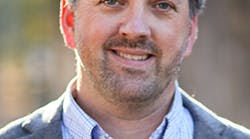Editor's Note: This post was sponsored by Infor.
One of the ways that the COVID-19 pandemic is shaping industry is that it has brought renewed focus on the benefits that digitalization can bring to plant operations, from the stockroom to the C-suite.
Kevin Price is technical product evangelist and product strategist at Infor, a global company that provides enterprise software products for every aspect of business. In these roles, Kevin is globally responsible for product strategy functions for the Infor EAM, Infor MP2, iProcure, and Energy Performance Management product families. He also is a longtime contributor to Plant Services, having written several articles and presented on many of our webinars.
Plant Services recently spoke with Kevin on how maintenance conversations are evolving from enterprise asset management (EAM) to asset performance management (APM), and why reliability is taking on new urgency in our current post-crisis moment.
Q: Can you tell us what you’re hearing from your customers this year, on why asset reliability has taken on a new urgency?
A: There are several factors we’re seeing: a resurgence of the word, a resurgence of the practice, and we’re certainly seeing a resurgence in the need to be able to put it into our solution research and development. Whenever there is a downturn in an economy, companies look at what assets you have and how to get the most out of them. That’s always going to be the case. And in an upturn economy, you’re buying new assets – which will almost always require new maintenance management techniques along with traditional practices.
In either scenario, organizations have to rethink how they are structured and how they run. From an Infor EAM perspective, this means reliability. It’s looking at making your assets last longer, looking at your failure analysis, doing different types of decay curves, doing things that are deep into the reliability mechanisms that we’ve had for years and continue to build upon.
The conversation is evolving from enterprise asset management (EAM) to asset performance management (APM). This is wonderful as it brings innovations around automation back into the equation – a lot of the condition monitoring, the internet of things, visualization on digital twins, all that kind of thing.
You also have outputs that are interesting. We do asset investment plans today, and what customers are wanting to see is for those to be more models that you can tweak, you can adjust. They’re wanting to see all that as a natural part of EAM, they’re not wanting to see that as a third-party integration – which is another reason for the evolution from EAM to APM.
We build on these capabilities, by adding more flexibility, scalability, and a lot more “model-esque” capabilities. The idea is we get into this conversation of not just the maintenance department and operations. You get into plant engineers, which is where we want to see this conversation go in many different ways. You get into the CFO’s office on the cost that you have for, the COO’s ability to represent that schedule and meet it. And of course, the CEO.
People are really going back to those ideas of reliability: asset reliability of what I can be able to do to make sure that the service that I provide to get revenue or the product that I create to get revenue is done in a way that’s sustainable.
With methods like asset reliability coming back into play, there is so much more opportunity to really affect the world in a positive way.
Q: Can you talk about what outcomes are most important these days?
A: You bet. A lot of the data is more available, it’s more pervasive, to be able to make those decisions than ever before – and there’s more people involved into the conversation. It’s literally a deluge of data, with 10 times more people who want to understand it.
And we all knew that, right? Because we’ve been talking about that for years and more equipment gets more and more and more data coming in….and here we are!
The most common customer question is this: how can take I that data and how can I build a business outcome of it? Is it getting more specific in the reliability nature – the preventive maintenance schedules, the preventive maintenance techniques, approaches? Or something else? These are types of questions that you look at in reliability that we would do in the past, but we didn’t have as much data to be able to make sense of it all. And now we do.
Infor EAM helps in a big way as it looks at what that data represents – time efficiency of equipment detail…and we look at the accuracy of information when it’s captured. We look at the compliance issues that demand that data and make sure that the drop-downs are easy to select and go through and not have to be a bunch of scribble on a sheet of paper. Quite easy if you think about it.
A lot of these business outcomes and these values that we do have always been there, and they’re now becoming a lot easier to obtain, a lot more common to obtain. But I definitely think that there needs to be the mindset of asset reliability and sustainability from the beginning.
Q: It’s sort of a truism that the toughest resistance to reliability programs is cultural, getting people to get on board and embrace that change. What role do you see asset management software playing in helping teams overcome any kind of internal resistance to reliability?
A: I totally agree with you that the most difficult things, from people, products, and processes, are people. The asset management programs need to really empower the people, and the people need to be able to adopt it in a big way.
People are always a challenge. To understand it well, you have to walk a day in the life of their shoes to understand what to do, why, how, when, and where. Which is why we invest heavily into usability. Mobile, for example, needs to be a part of a natural extension of our system. It has to be who we are, because that’s who we are: we’re out in the field. When you think about asset management software, enabling that success of the reliability program, you have to give guys the right tools at the right place at the right time. Like Asset Performance Management, it cannot be a third-party “bolt-on”
You still have a cultural change, and this aspect has been around for 20, 30 years of just willingness to adopt the tech. So that will never completely go away.
From a software perspective, that should be our challenge. That shouldn’t be the customer’s challenge. The customer should just be able to configure it, pick and choose. They shouldn’t develop this on their own. They shouldn’t worry about integration on their own. They shouldn’t worry about data synchronization on their own. That’s our problem. That’s why we take on a lot of that.
The technology is getting to a point where it’s very flexible to be able to make it a lot easier. And with folks out in the field, in their house, doing their own day-to-day life, they’re getting more exposed to these types of things. But at the end of the day, young professionals coming out of school don’t want to see a laptop, they don’t want to see a desktop for sure. They want to see everything that is on a mobile solution, which is another reason why mobile is critical.
The definition of asset reliability and sustainability means innovation. It will change the face of what engineering looks like in every vertical.
Q: What does it take to bring a reliability champion onboard?
A: The thing that is going to matter the most is, how can you take that ground-level example that you’re looking for and make sense of it at that C-suite level?
In order to be able to do that, you need to understand the use case, the value that comes behind it. Our ownership now is Koch Industries, One of the reasons why they’re successful is because they have a relationship with good profit, where what we mean by that is, we’re able to bring value to our customers to the extent that it increases their profit, reduces cost, and is sustainable and reliable.
What we do to be able to get to that point is we go through something called a Decision Making Framework (DMF). It looks at that use case, understand the economic benefit that it can have to the organization at every level – what the end goals could be, what the framework elements could be in the impact of perhaps production, either reducing costs, increasing margin, or the safety that we offer in that production process.
If we’re able to improve the process/product, make it safer, make it more reliable, make it more sustainable, then it’s going to help the next person above, and the next person above, and the next person above. If we’re able to provide a good profit for them, we’re able to get good profit ourselves. The idea behind that whole partnership, that equilibrium that we have between the two is one of the reasons why I think it’s important to bring in collaboration feedback from every level of the organization so that it affects the C-suite.
This story originally appeared in the July 2021 issue of Plant Services. Subscribe to Plant Services here.

